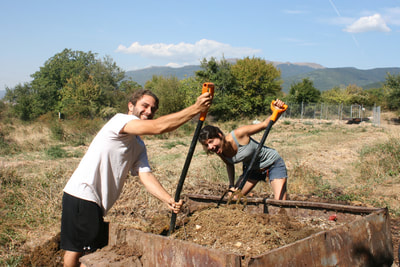Advance Planting Preparation Trials
Advance planting preparation is basically the addition of organic matter into the planting zone 6 - 12 months before planting to improve soil conditions for the incoming plants. This can be in the form of mulches that suppress existing growth and decompose in situ or in the form of green manures that replace the existing growth and improve the soil.
The aim of this trial is to discover methods that are inexpensive, time efficient, least disruptive to the existing wildlife and that provide the optimal conditions for the incoming plants. You can find a write up of how we developed this garden in our blog here
The aim of this trial is to discover methods that are inexpensive, time efficient, least disruptive to the existing wildlife and that provide the optimal conditions for the incoming plants. You can find a write up of how we developed this garden in our blog here
Our five methods for advance planting preparations
|
1. Inverted Sod and Mulch - (Soil - Straw)
2. Green Manure - (Plough - Till - Sow White Clover - Sainfoin and Marigolds) 3. Dig over and Sheet Mulch - (Card - Manure - Straw) 4. Sheet Mulch - (Card - Manure - Straw) 5. Straw Mulch (Straw) 1. Inverted Sod - Method one entails slashing the existing vegetation to ground level and leaving it on the surface. A layer of inverted sod is then applied to cover the surface of the bed. In some cases you may wish to dig out the top soil from the pathways and this can be inverted on to the bed area. In this case we wished to leave the pathways grassed and used top soil removed from a pond excavation on site. Following the top soil a layer of straw mulch is applied approx 10-20 cm deep. 2. Green Manure - Method two removes the existing vegetation and replaces it with plants that can improve the soil for the incoming plants. For example on sites with low fertility soils nitrogen fixing green manures are great way to lift Nitrogen (N) to appropriate levels. The green manures can also add significant quantities of organic matter to the soil improving structure and drainage and can serve the needs of beneficial insects. 3. Fork over and Sheet Mulch - Method three entails slashing the existing vegetation to ground level, forking over the surface of the beds and then placing a card/cloth layer to cover the soil surface and a layer of manure on top of the card/cloth. We used approx 30 L of manure per m2 and finally topped this with a 10-20 cm layer of straw. 4. Sheet Mulch- Cardboard layer, manure layer , straw layer - Method 4 is the same as above but without forking over the beds. 5. Straw Bales Method five is quite simply slashing the existing vegetation to ground level and applying a 20 cm layer of straw to the surface. |
How we are measuring the effectiveness of each method
The criteria we are judging the effectiveness of the methods and how we will measure effectiveness is as follows:
- The smallest amount of effort for the greatest benefit i.e in labour, materials - Record of Inputs
- The least expensive method (without sacrificing quality) - Cost Analysis
- The least disturbance to the existing ecosystem - Entomology Survey
- Mineral analysis compared to base sample - Mineral Analysis
- Physical analysis compared to base sample - Soil Test Card
- The beds should provide great soil conditions for the incoming plants, i.e, free from competitive neighbouring plants, good structure, moist and fertile, free draining - Observational Report
Telephone+359988342649
|
|












